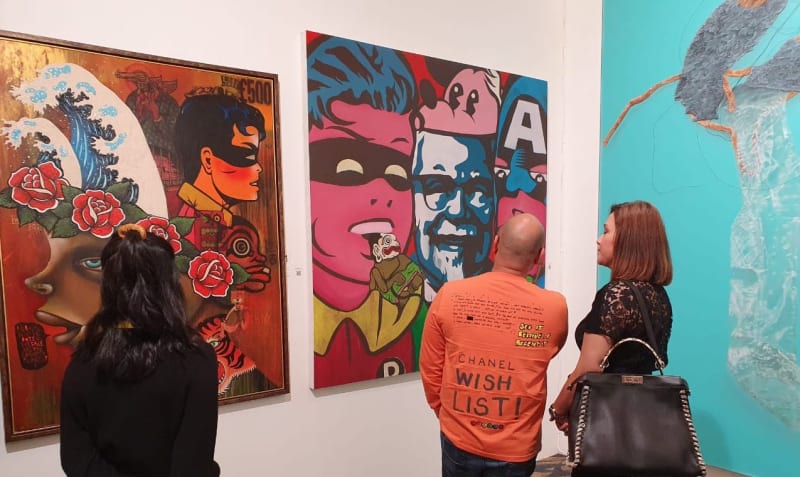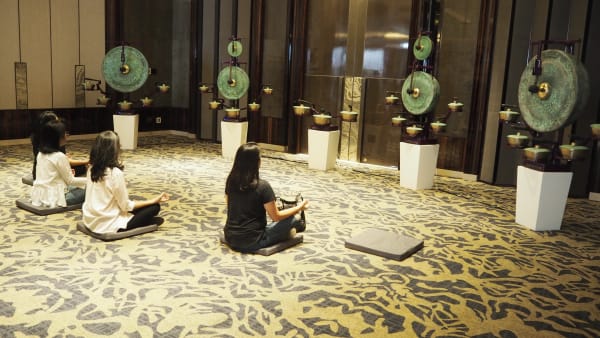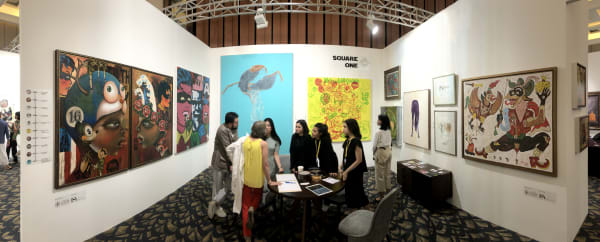Art Moments Jakarta 2019: Square One
Art Moments Jakarta is a group exhibition focusing on Indonesian art and artists. The art fair is set up by a team of art professionals and experienced fair organizers from Jakarta and Singapore.
Indonesian Luxury took part in Art Moments presenting an exhbition titled SQUARE ONE. Square One showcased the early works of established artitsts, some of which played a pivotal role in the advancement of their career and served as a stepping-stone in establishing the artists dna and personal styles. These pieces are the groundwork of their thoughts; reminiscing a time and place when the artists were still unsure of their artistic direction, the journey and the final destination or how their art would be received by the public and finaly distinguishing their artistic identity.
Sqaure One exhibited works by Angki Purbandono, Christine Ay Tjoe, Gede Mahendra Yasa, Handiwirman Saputra, Heri Dono, I Made Wianta, Indieguerillas, Ugo Untoro, Uji “Hahan” Handoko, Wisnu Auri and Yunizar.
For more informationn about the exhibition and aritsts, download or view our Press Release below -
Indonesian Luxury is pleased to announce that it will be joining the inaugural fair of Art Moments Jakarta, which will take place between the 3rd and 5th of May 2019, at the Sheraton Grand Jakarta Gandaria City Hotel, Jakarta. Indonesian Luxury will be presenting SQUARE ONE, a collection of early works by nine Indonesian contemporary artists.
Indonesian Luxury will exhibit works by Angki Purbandono, Christine Ay Tjoe, Gede Mahendra Yasa, Handiwirman Saputra, Heri Dono, I Made Wianta, Indieguerillas, Ugo Untoro, Uji “Hahan” Handoko, Wisnu Auri and Yunizar.
These artworks have all played a pivotal role in the advancement of their career and greatly influenced the contemporary art world by projecting their artistic identity. The exhibition provides a window into a significant period in the artists’ early creative vision - their ‘square one’.
At the beginning of the twenty-first century, while Indonesia was going through tremendous economic developments, some of these artists marked their entrance into the international art scene and developed sophisticated yet formalistic artistic styles.
In 2003, Heri Dono was the second Indonesian artist invited to the Venice Biennale after Affandi in 1954. In 2011, Handiwirman Saputra held an exhibition in the National Gallery unveiling the series “Tak Berakar dan Tak Berpucuk “comprising eight artworks. One in the series was chosen for the 58th Venice Biennale central exhibition this year, making Handiwirman the third Indonesian artist to ever exhibit at the famous biennale. Indonesian Luxury will also exhibit another work “Akhir Pekan dan Projek Organik dari Tak Berakar dan Tak Berpucuk #8” together with three paintings from Heri Dono at Art Moments Jakarta.
The works on display convey the narrative from starting at “Square One”, revealing the groundwork of the artists’ thought, imagery, collage, composition and a mixture of media that distinguish their artistic identity. Square One represents a time and place where the artworks and the artists are inseparable, yet it places them next to each other to highlight a very clear sense of individuality.
About Indonesian Luxury
Indonesian Luxury offers the most comprehensive online resource for everything you need for acquiring, building or styling your home in Indonesia. Indonesian Luxury aspires to be the ultimate platform for reaching all access points of the Indonesian and Southeast Asian art, luxury design, and properties through its extensive catalogue and exclusive events.
About Art Moments Jakarta
Art Moments Jakarta will have its inaugural fair on 3-5 May 2019 at the Sheraton Grand Jakarta Gandaria City Hotel in South Jakarta. The fair is set up by a team of art professionals and experienced fair organizers from Jakarta and Singapore. Art Moments will not only showcase spectacular art from a selection of galleries, but it will also present an exceptional sculpture show. The sculptures will be located at Gandaria City Mall, amongst the international museum quality sculptures publicly displayed at the mall.
About the Artists
Angki Purbandono
Angki Purbandono, born in 1971, is one of Indonesia's most prominent artists from culturally rich Yogyakarta. He's noted for his scanographies, where he creates photographic images by scanning objects using a flatbed image scanner. The effect of this method is different from taking a photograph with a camera. With a flatbed scanner the depth of field is reduced, and the distance is much closer making images vivid and very detailed. The light that is emitted from the scanner, being so close to the objects also casts a floodlight effect and contrasts the objects well against its background.
His work was featured in numerous exhibitions at key galleries and museums, including the Asia Society and Museum, New York, and the Saatchi Gallery. Angki Purbandono's work has been offered at auction multiple times, with realized prices ranging from $514 USD to $13,686 USD, depending on the size and medium of the artwork. Since 2009 the record price for this artist at auction is $13,686 USD for the Golden Dragon (Noodle Theory Series), sold at Christie's Hong Kong in 2012.
Christine Ay Tjoe
Indonesian artist Christine Ay Tjoe addresses themes of philosophy and spirituality in her work, focusing on the human condition, as filtered through her own subjective experience. Although visually seductive, her expressive work deals with abject subject matter, attempting to connect with our most powerful emotions and deep psychological fears.
Born in 1973 in Bandung, Indonesia where she continues to live and work, Ay Tjoe began her career making graphic works, specifically intaglio dry point prints and then textiles. Her diverse oeuvre now encompasses painting, drawing and sculpture as well as large-scale installations.
Christine Ay Tjoe was recently announced as the winner of the 2019 Asia Arts Game Changer Awards Hongkong.
Gede Mahendra Yasa
Gede Mahendra Yasa is a conceptual painter. His painting teeming with depictions of everyday life in Bali, interspersed with the artist’s own versions. His work also serves as a political analogy. He presents his concept of painting with divisions between the idea of paintings from Western and Indonesian art history.
In 2017 after his birthday, Mahendra Yasa found his new concept about painting in the abstract. He explores a new medium, encaustic, where he made the paints himself. For Mahendra Yasa, these abstract suites are more directed towards the body and what marks the body makes; the painting is not just marked with big and small brushes, but also with jabs and touches from the flick of the wrist, bolder strokes from elbow and the large sweeping gestures that come from the shoulder and from the whole body.
Handiwirman Saputra
Born in Bukkittinggi (1975), West Sumatra, Handiwirman Saputra is the co-founder of the Jendala Art Group. Alongside Entang Wiharso, Christine Ay Tjoe, Rudi Mantofani, and other colleagues from the Institut Seni Indonesia, these Post-Reformist artists adopted mundane materials as a basis for artistic exploration. Often seen as reactionary following the politicized production of artists under the Suharto regime, Jendala artists provoke formalist readings by critics yet collectively address a range of concerns. Saputra himself works between installation and painting. His use of found objects is often suggestive of events, landscapes and images but in themselves resist any connotations of symbolism and metaphor.
The ambiguity of his works is often heightened by a shift in scale, transforming the banal into the monumental. However, the artist is reluctant to participate in the 'grand narratives' of Yogyakarta art, which has been dominated by figurative and social concerns. Instead Saputra works associatively, imbuing his works with a sense of the absurd and a visual clarity that has become a hallmark of his practice since mid-2000.
Heri Dono
Born in Jakarta in 1960, Heri Dono isa Yogyakarta-based leading contemporary artist and the first Indonesian to break into the global art scene in the early 1990s. He has since then been participating in no less than 27 international biennales. He is also the only contemporary Indonesian artist to have been invited to the Biennale Arte's own curatorial exhibition in 2003 (Zone of Urgency). Heri Dono is unquestionably one among the Indonesian contemporary artists from the late 1980s generation that are best known to contemporary art international community.
Since early in his career, he has been around the world to participate in numerous exhibition and workshop invitations in various countries. Heri Dono is known through his installation that is composed from his experiments with the most popular Javanese folk theater: wayang.
In his paintings, Heri Dono makes the most use of wild deformations and free fantasies out of which emerge characters of wayang stories. Adding his profound knowledge of children’s cartoon films, animation films, and comics, Heri Dono’s canvas is always filled with highly astonishing characters of intertwined fantastic and absurd stories. In all these Heri Dono will sometimes insert his own critical remarks on socio-political issues in Indonesia and abroad.
I Made Wianta
I Made Wianta was born in Apuan, Tabanan, Bali, on 20 December 1949. He studied at the school of fine art in Denpasar and The Indonesian Academy of Fine Art in Yogyakarta. Before completing the program, however, he went to Brussels, Belgium. For several years he worked and visited museums and galleries there, then returned to Indonesia in 1972. He has participated in many group and solo exhibitions in Indonesia and abroad, including the Venice Biennale in 2003, and Mike Weiss Gallery in New York, USA in 2005. His artistry has been documented in the books Made Wianta (1990), Made Wianta : Universal Balinese Artist (1999), Made Wianta : Art and Peace (2000), and Wild Dogs in Bali : The Art of Made Wianta (2005). He now lives and works in Denpasar, Bali.
During his early career, Wianta studied the Balinese classical wayang style of painting from master artists in Kamasan, Klungkung. His drawings of Balinese spirits and creatures have novel, peculiar and personalized shapes. When he used colors, the works were similar in structure to his drawings but did not have figurative elements. Instead, he began painting in a kind of abstraction that systematically used small dots of color with a mixture of linear contours and flat surfaces. Then he went on to create geometrical constructions that combined spontaneous calligraphic strokes. His work is represented in the collection of The Neka Museum in Ubud, Bali. He also does installations and performance art to convey his concerns about social and cultural change.
Indieguerillas
Founded in 1999, Indieguerillas is a duet of artist from Yogyakarta, Indonesia. They are Santi Ariestyowanti, and Dyatmiko“Miko”Bawono. The former has a Visual Communication Design background and the latter Interior Design. Both are alumni of The Faculty of Art of the Indonesian Institute of the Arts in Yogyakarta (ISI Yogyakarta). In addition to their being known for their interest in folklores, Indieguerillas are also recognized for their proficiency at visual effects and inter-media experimentation in their works.
Ugo Untoro
Ugo Untoro, born in Indonesia in 1970, graduated from the Indonesian Institute of the Arts, Yogyakarta. He continues to live and work there. He has held solo exhibitions in Indonesia, Singapore, and Kuala Lumpur, as well as participated in-group exhibitions in the United States of America, China, France and Vietnam. He is known to have brought contemporary Indonesian art to a new level. Over the past decade, Ugo Untoro has elaborated a collection of paintings, drawings, poems and writings. His signature style is raw and spontaneous influenced by his street background and graffiti art knowledge.
His entry to the Philip Morris Art Awards in 1998 was placed within the Best 5; and Tempo Magazine of Indonesia named him Man of the Year in 2007.
Uji “Hahan” Handoko
Uji “Hahan” Handoko Eko Saputro (b. 1983) is an artist based in Yogyakarta, Indonesia whose practice is based on observations and critique regarding his sociopolitical environment. His ongoing project, Speculative Entertainment, focuses on how values throughout the contemporary art ecosystem are constructed.
Uji 'Hahan' Handoko's work is characterized by an ongoing tussle between 'high art' and 'low art'. Blurring realism with decoration, each work illustrates a point of contact that exists between urbanization and agrarianism, the East and the West or between the local and the global. Hahan incorporates film, music and street culture into a distinct visual language where the canvas explodes with bold colors that slip over strong outlines. The color slippage adds to the sense of movement and spontaneity in what can be described as a topsy-turvy reality.
Born 1983 in Kebumen, Uji ‘Hahan’ Handoko graduated from the Faculty of Fine Art at Indonesia Institute of the Arts (ISI) in Yogyakarta. In 2008, Hahan participated in the National Art Studio’s artist in residence program in Seoul, Korea and in the same year was named the top 30th finalist for the Sovereign Asian Art Prize.
Wisnu Auri
Wisnu Auri (b. 1981, Yogyakarta, Indonesia) has also participated in numerous group exhibitions since 2002, including in Seoul, Korea and Dubai, UAE. As a conceptual artist, Wisnu expresses himself in both two-dimensional and three-dimensional formats. From his past series of collages, the clean lines of his installations stand in stark contrast to his drawings, which appear disorganized and chaotic. The artist’s seemingly perfect display of everyday objects contains multiple layers of meanings in term of its word usage and aesthetics, which is an example of how Wisnu deftly combines ideas, language and visual elements in his art. There is a spirit of spontaneity throughout Wisnu’s art, quite unusual in the Indonesian context nowadays.
In his latest exhibition titled I am just Doing Aesthetics, he explores the ‘power of disturbing taste,’ which seeks to define judgments about art and the beauty of nature. Moving away from his previous series, in which he focused on found objects, this emerging artist returns to paintings yet continues with his fascination of nostalgia and the present; the struggle between beautiful and ugly, present and past and the evolution of art styles. In this exhibition, he focuses on taste as an individual's personal and cultural patterns of choice, and draws distinction between things, such as styles, manners and works of art. Auri questions the viewer's taste and their ability to judge what is beautiful, good and proper.
Yunizar
Yunizar spent his formative years at the Indonesian Institute of Arts in Yogyakarta - a school of national pride in the heart of progressive art making in Indonesia. Yunizar’s training reveals itself in his sophisticated expressive style, articulated through playful composition and subtle palette. Executed primarily in acrylic and pencil, his works stand out in terms of texture, color, brushwork and rhythm. A restrained palette of cool colors - yellows, browns and greens - is deliberately dirtied and smudged in his working and reworking of the canvas. The result is a highly tactile work that entices the viewer to feel the piece.
Coretan, Yunizar’s Solo Exhibition at the National University of Singapore Museum in 2008 became the cornerstone of the artist’s signature style. Repetition and technique of scribbling mark a desire for meaning to be limitless in perspective. The spontaneous lines are reflections of the artist’s resistance of with the constrictions that both text and image sometimes take. The works are composed of illegible scribbling lines across the canvas, appearing as fragments of text that struggles to find form or intelligent representation. Working with limited color, mostly monochromatic, his works reveal a play of lines and textures coming together to create clear rhythms and strong composition. The simplicity of visual elements within his works, according to Yunizar, is the result of a personal aesthetic judgment. He seeks beauty, especially in the trivial and in what is deemed by all else as useless and unimportant. To capture intuition and impulse, that is the great aim of the artist.



